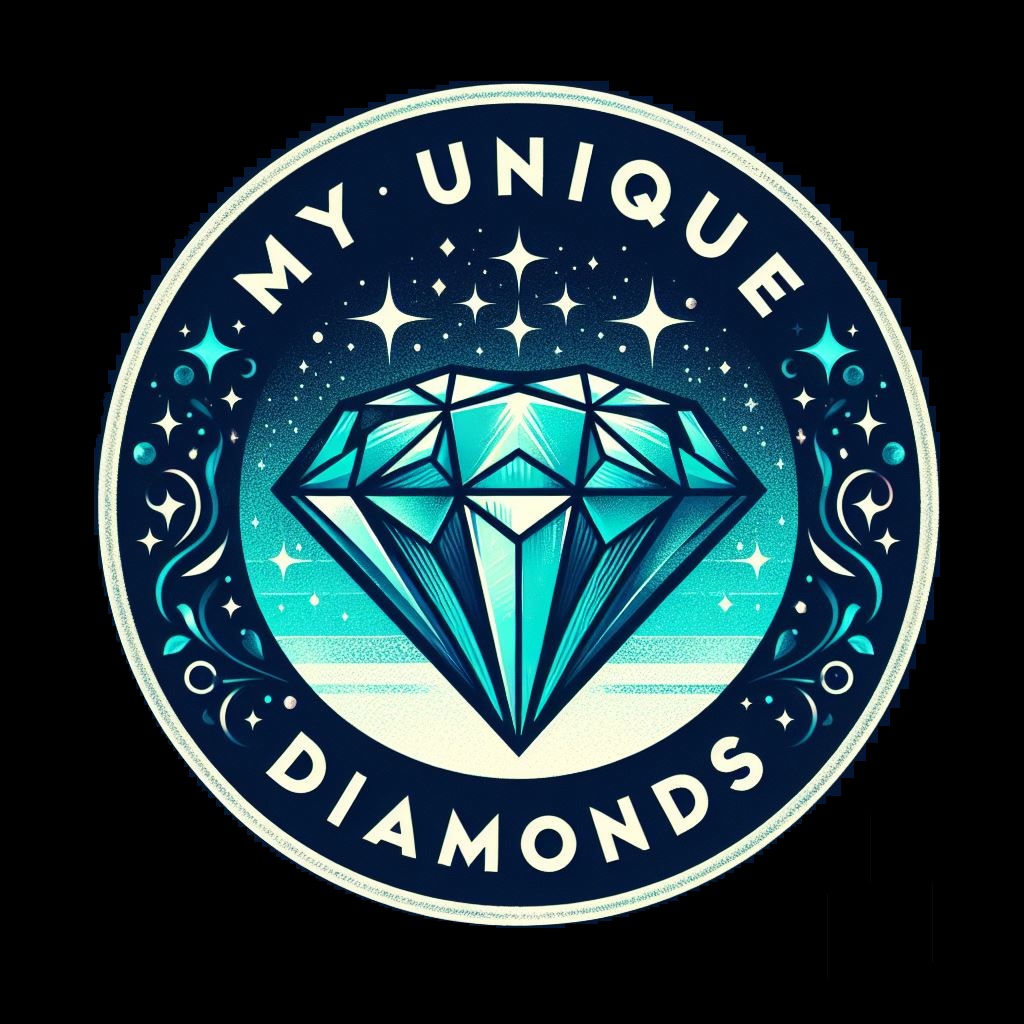The Enduring Allure of Famous Diamonds
Introduction to the mystique of famous diamonds
There are diamonds which are immersed in legend, whose origins are enveloped in the mists of mythical and epic tales. Ever since the first diamonds were discovered in India in the 17th century, stories have unfolded of gems of unthinkable sizes being brought back to Europe and either sold or gifted to royal families or wealthy merchants. Jean-Baptiste Tavernier was among the first Westerners to visit the Indian mines and trade in diamonds. Many famous diamonds passed through his hands and are known to Europeans thanks to his travels.
For over two thousand years, India (and to a lesser degree Borneo) was the only source of diamonds. It is said that the Indian mines were almost depleted when diamonds were discovered in Brazil in the early 1700s, in the vicinity of the Minas Gerais province. Portuguese explorers found some ‘white stones’ which they sent back to Portugal to be examined. At first they were not deemed to be valuable, however, the real nature of the stones was soon revealed and a diamond rush ensued, adventurers hastening to the province seeking fame and fortune.
![]()
![]()
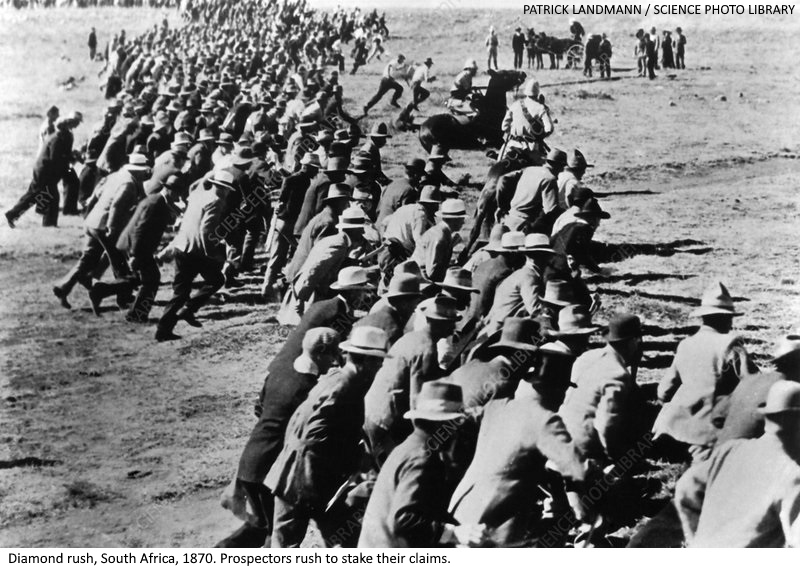
![]()
In 1866 the first sizable diamond was found in South Africa on the bank of the Orange River (central area of South Africa, from the Eastern Cape to Northern Cape provinces). The young son of a Dutch Boer farmer picked up a shiny pebble; no-one had any idea of its value until a mineralogist declared it to be a diamond of more than 20 carats! It was given the name of Eureka. More on this below, suffice it to say that three years later a shepherd found another stone in the same area; this gem was cut into the legendary Star of South Africa.
Stories behind the legends: The Hope, The Cullinan, and The Koh-i-Noor
Famous Indian Diamonds
Great Mogul Diamond
When Tavernier visited the Great Mogul of India in 1665, the king ordered all his jewels to be shown to the French jeweler. The Great Mogul (commonly named Aurangzeb) was the ruler of what we today refer to as the Mughal empire, which spanned a territory larger than India itself, comprising the present-day countries of India, Pakistan, Afghanistan and Bangladesh. The first piece which the king’s ‘chief of the jewel treasury’ placed in Tavernier’s hands was the piece de resistence of his collection: a raw diamond weighing more than 280 carats. This stone was to become known as the famous Great Mogul Diamond, and Tavernier tells us that when Aurangzeb’s predecessor Shah Jahan was presented with this stone during his reign, it weighed more than a mind-boggling 787 carats! Tavernier describes the stone as having been ground down [possibly to remove flaws or in an attempt to obtain a number of smaller gems; author’s note].
![]()
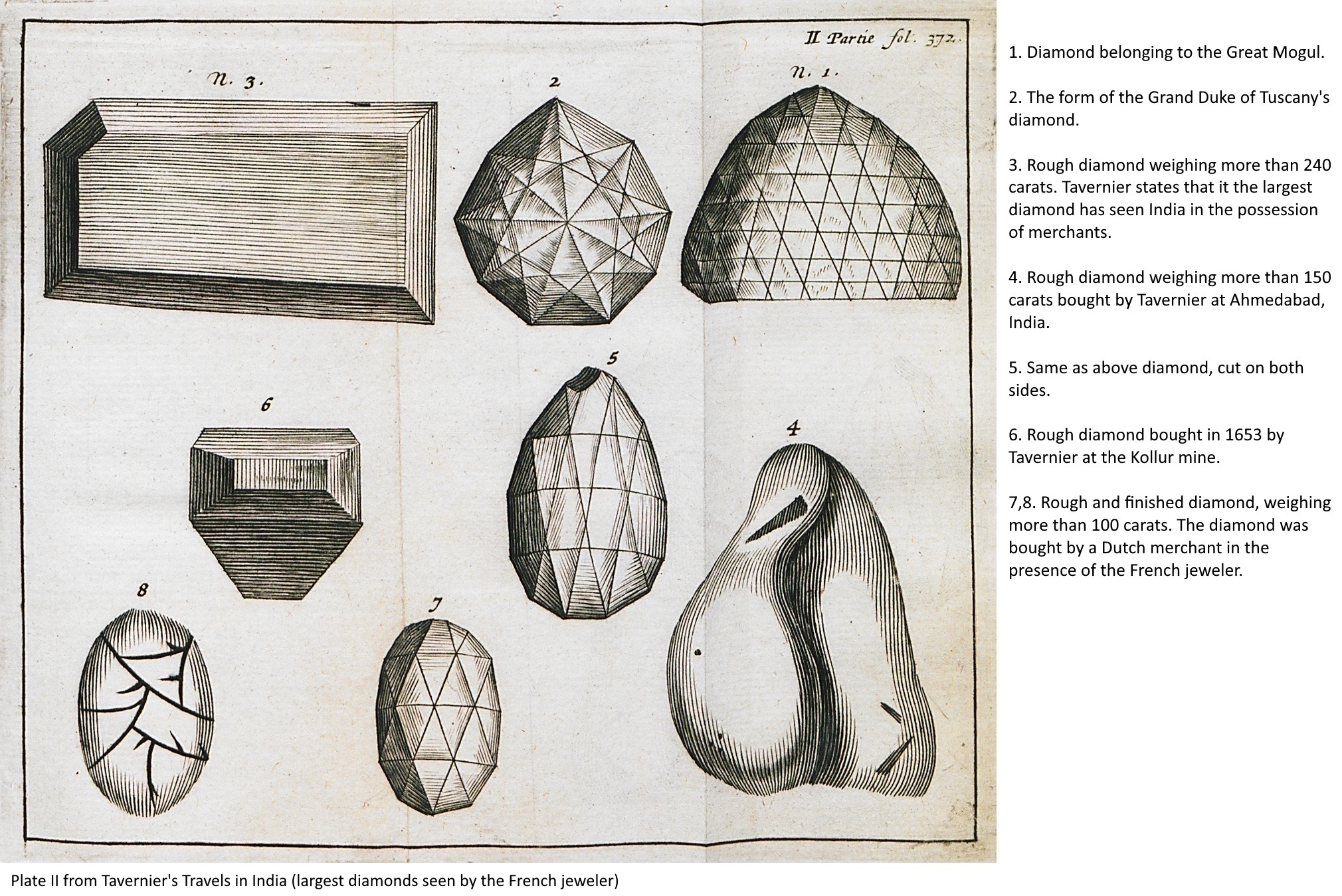
![]()
The French jeweler then relates the story of how the practically raw diamond was ineptly cut by Hortensio Borgio, who did not know his trade well. Instead of cleaving the diamond into a number of smaller flawless diamonds, Borgio ground it down, resulting in it losing a large part of its weight. This infuriated the Mogul, who instead of paying him for his work, fined him for every penny he owned, albeit sparing his life. According to the Encyclopædia Britannica, this diamond is thought by some to be the Orlov Diamond, which is mounted in the Romanov Imperial Sceptre, today owned by the Russian Diamond Fund.
The Koh-i-Noor
One of the worlds most famous diamonds, the Koh-i-Noor (Persian, meaning ‘mountain of light’) weighs 105,6 carats. Valentine Ball in his translation of Tavernier’s Travels to India, states that the Koh-i-Noor has been identified by some authors with the Great Mogul Diamond, or as having been one of the diamonds cut from the original raw diamond. However, this is today considered very unlikely due to its size and original lack of lustre. Little is known of the exact origins of the diamond, but the Encyclopædia Britannica states that it is most likely of Indian origin and was part of the loot the Persian ruler Nadir Shah deriving from his sack of Delhi in 1739. Through his descendants it finally reached the Sikh kingdom of the Punjab, which was annexed to the British Empire in 1849, the diamond being acquired by the British and becoming part of the Crown Jewels of Queen Victoria. Today it is mounted on the Crown of Queen Elizabeth The Queen Mother, held in the front cross. The diamond seen mounted in the cross on top of the crown is a crystal replica of the Lahore Diamond, which came to England with the Koh-i-Noor. According to The Royal Encyclopedia, the Lahore Diamond was worn by Queen Elizabeth as a drop necklace pendant.
![]()
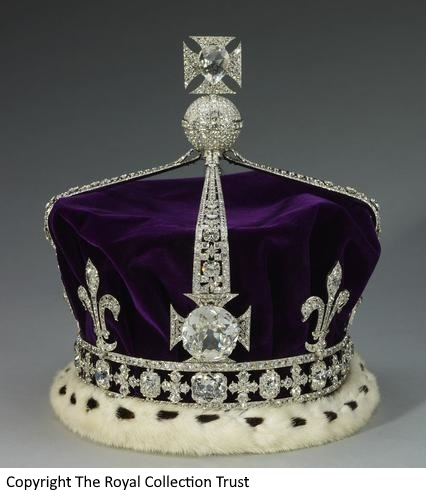
The Darya-i-Noor
Referred to as the Koh-i-Noor’s sibling, the Darya-i-Noor (Persian, meaning ‘ocean of light’), is larger with its approximately 185 carats. The Encyclopædia Britannica states that it is the finest in Iran’s collection of crown jewels. It is of pink color and has a rectangular shape. Also of Indian origin (said to come from the fortified citadel of Golconda), some experts have identified the Darya-i-Noor as being the tablet-shaped gem described by Tavernier in his travels (see number 3 of Tavernier’s drawings of the diamonds from his Travels in India in the image above). Another diamond, the Noor-ul-Ain (Persian: ‘light of the eye’) is believed to have been cut from Tavernier’s tablet-shaped gem. This diamond is also pink in color and is the centerpiece of the tiara of the same name, which is equally part of Iran’s crown jewels.
![]()
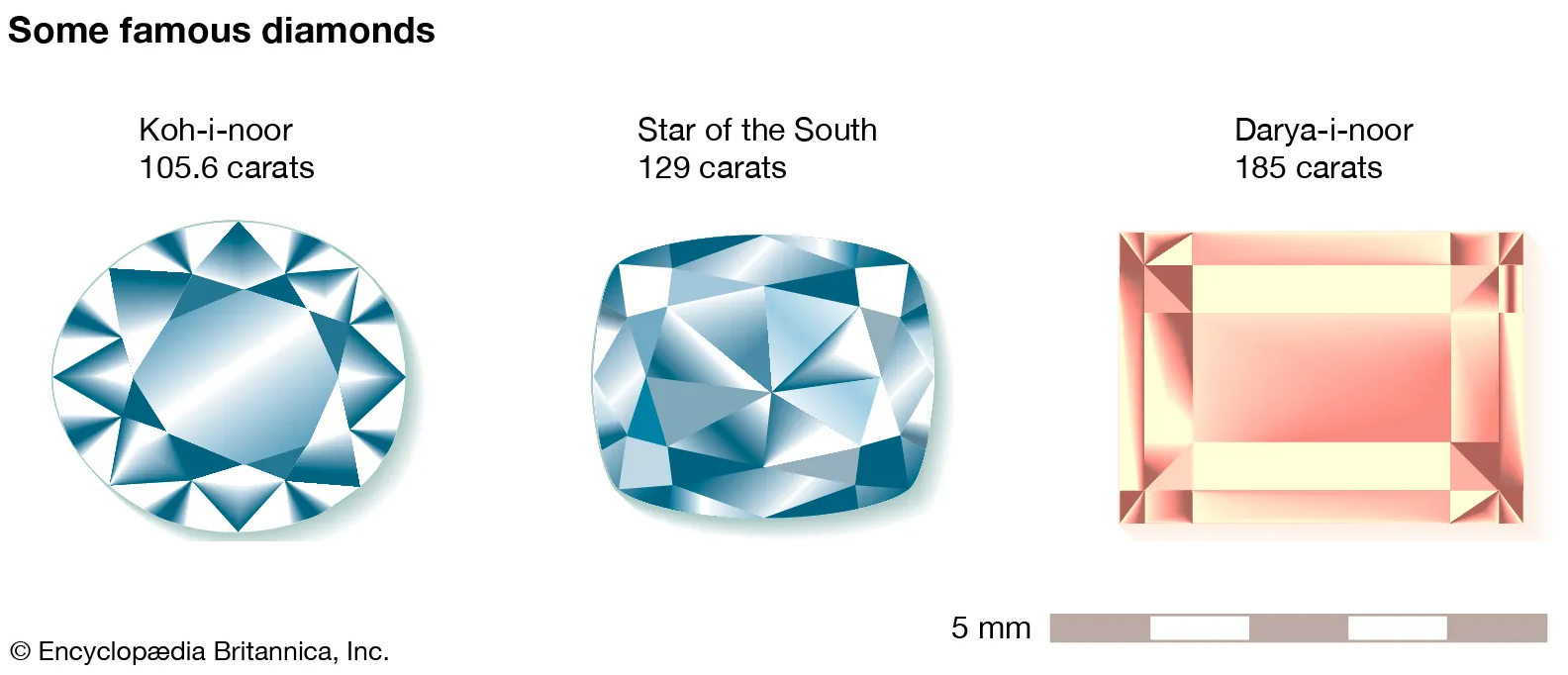
![]()
The Hope Diamond
This is a gem said to have been purchased by Tavernier himself in 1666 from the Kollur mine in India. The diamond is described as being a deep, steely blue and weighs a little over 45 carats. It is approximately the size of a walnut and is very rare due to its color. In 2006, a recent estimation of its price was $200 million. In 1668 Tavernier sold the raw diamond (named the Tavernier Blue at the time) to King Louis XIV of France (‘Le Roi Soleil’, the Sun King) and this gem was cut into a heart-shaped diamond of 67 carats named The French Blue. It is from this diamond that the Hope Diamond is thought to have been cut decades later. Eventually, it was bought by American jeweler Harry Winston who donated it to the Smithsonian National Museum of Natural History in Washington, D.C, where it is on permanent exhibition to this day.
Famous Brazilian Diamonds
Star of the South
This diamond has become famous for several reasons: as well as being the first Brazilian diamond to reach international fame, its history, unlike many other legendary diamonds, is well documented. The raw stone weighing over 261 carats, it was discovered in 1853 by a slave woman in the Bagagem River in the state of Minas Gerais (we know this thanks to French mineralogist Armand Dufrénoy). The cut stone weighs just above 128 carats and the resulting diamond is a cushion-shaped faceted gem of a pinkish brown color.
![]()
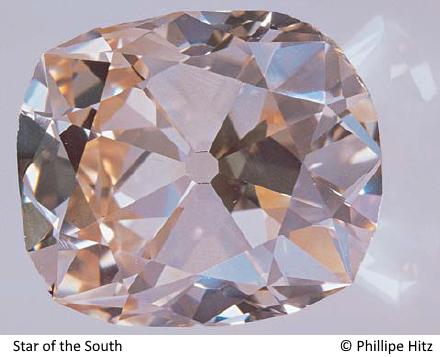
Famous South African Diamonds
Star of South Africa
In 1869 an African shepherd found another stone in the same Orange River area as the aforementioned Eureka diamond. This gem weighed 83.5 carats and was cut into an almost 48 carat pear-shaped diamond which would become known as the Star of South Africa. The discovery of this stone caused an extensive diamond rush and about a year later thousand of claims were made along the Orange and confluent Vaal rivers. After diamonds were found in the soil of a farmers property, the prospectors moved away from the rivers into dry earth. Many miners came from all over the world and formed mining camps, which eventually became urban settlements such as the famous town of Kimberley (more about this important town later when discussing Ethical Diamonds). The exact ownership of this diamond seems to be a mystery today, but the Vault of the Natural History Museum in London is known to have had it on display in recent years. It should not be confused with the Great Star of Africa or the Lesser Star of Africa discussed below.
The Cullinan Diamond (Great Star of Africa)
The Cullinan Diamond was named after the manager of the mine near Pretoria where it was found. When the raw stone was discovered, it weighed an astounding 3106 carats, the largest rough diamond ever found. According to the Royal Encyclopedia, in 1907, it was offered by the Transvaal government to King Edward VII as a gift for his sixty-sixth birthday. It was deemed too large to cut into a single diamond, which resulted in it being cut into at least four large diamonds and several smaller gems. The task was assigned to the J. Asscher firm of Amsterdam and what followed is history. The Cullinan I and II, the largest resulting gems, were presented to King Edward VII at Windsor and are today incorporated into the Crown Jewels of the United Kingdom. Cullinan I (aka First Star of Africa), a pear-shaped diamond of 530 carats, is set in the Sovereign’s Sceptre and Cullinan II (aka Second Star of Africa), a 317 cushion-shaped gem is set in the Imperial State Crown. These are held and worn by the monarch at every coronation and are the most important symbols of the monarch’s authority.
![]()
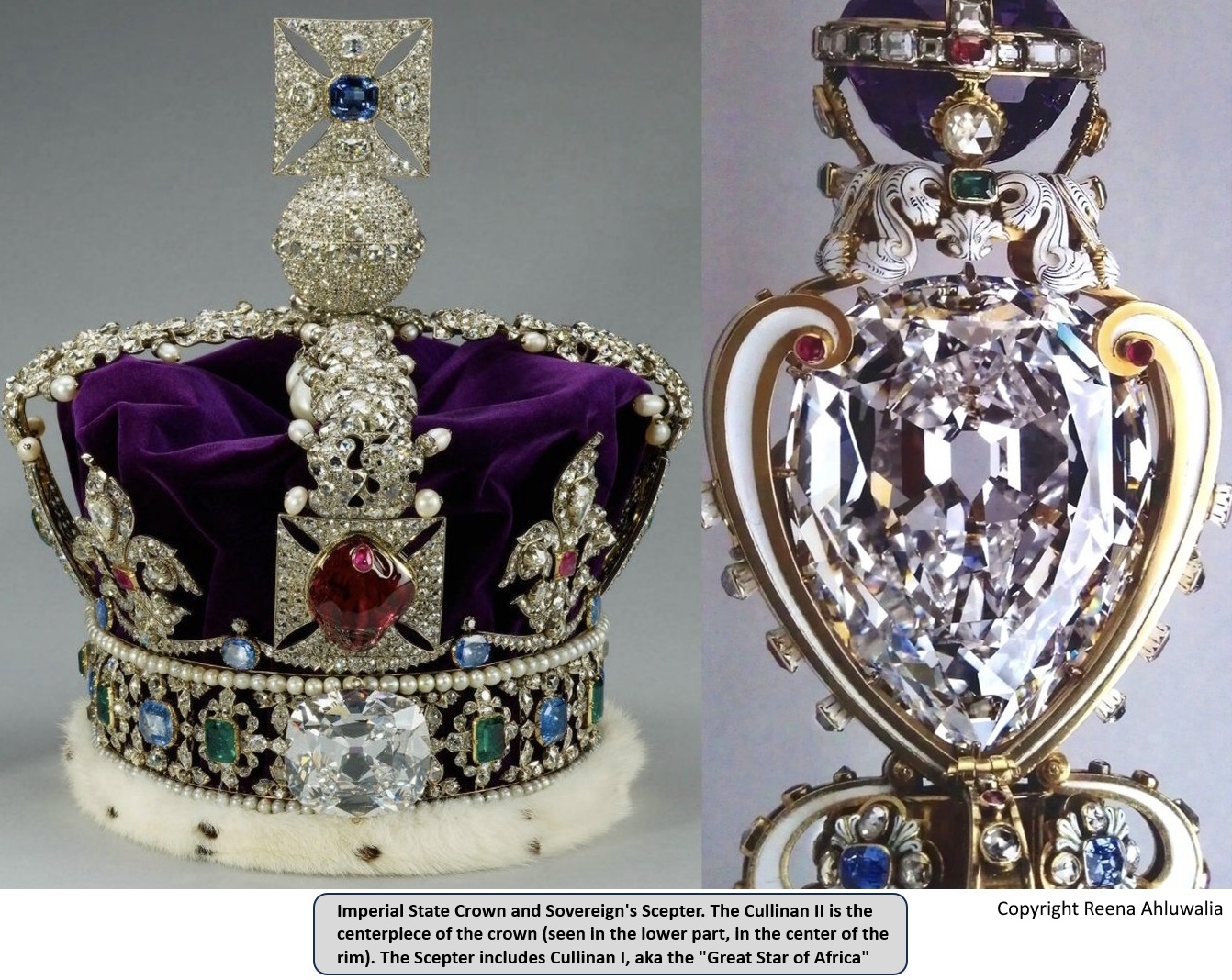
![]()
![]()
Links to more knowledge
Spotlight on South African Diamonds (GIA)
Star of the South: A Historic 128 Ct Diamond (GIA)
Books of interest
The story of diamonds (Milne, Jean. 2000, Linnet Books, North Haven, Connecticut.)
Hope diamond: The Legendary History of a Cursed Gem (Kurin, Richard. 2006, Smithsonian Books)
